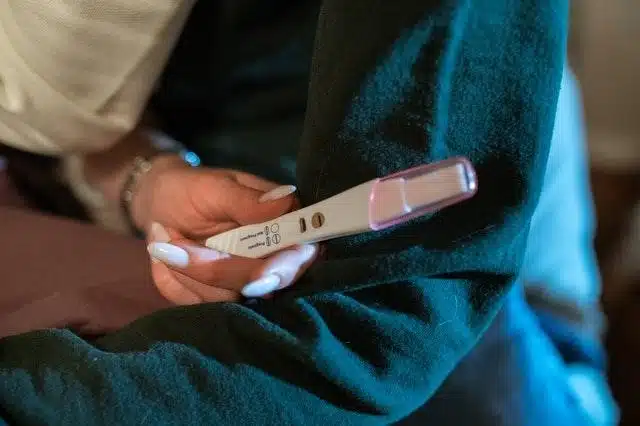Do you want to know when you ovulate? Not many women do, but those who do have a greater chance of getting pregnant. If you are actively trying to conceive, keeping track of your cycle can be pretty stressful. What’s the best way to keep track of ovulation and fertility?
The OV Calendar is a simple tool that will tell the most fertile days of your cycle. It helps you know your fertility rhythm. This kind of information is very important because it’s helpful, especially when controlling birth naturally. It also helps when you’re trying to get pregnant.
The calendar is easy to use, just enter your menstrual cycle length and start using it. It will tell you when you can get pregnant, when not to have sex if you want to avoid pregnancy, and how long your fertile window lasts.
We’ll discuss the menstrual cycle a bit, then proceed to how you can calculate your ovulation rhythm.
What causes the menstrual cycle?
The average menstrual cycle lasts 28 to 32 days. The first day of your cycle is the day when your menstruation begins. Usually, ovulation happens around day 14.
An egg is released from your ovary during ovulation. This egg leaves your ovary and goes down your fallopian tube, where it can be fertilized by sperm to result in a pregnancy. If there is no pregnancy, your menstruation will start roughly 14 days following ovulation.
Marking the starting day of your period on a calendar is an excellent place to start if you want to keep track of your menstrual cycle. Keep track of the days it takes you to start your period every month.
How to calculate the rhythm method
The traditional method
The stages for applying the traditional calendar rhythm method are as follows:
Note how many days are in your menstrual cycle
Record the number of days in each menstrual cycle on a calendar by counting from the start to the start of your following period.
Find out how long your shortest menstrual period is
From the total number of days in your shortest cycle, deduct 18. This number marks the first day of your cycle when you are fertile. For instance, if your shortest cycle is 24 days, take 18 off that number to get 6, which is the result. In this instance, the first day of your cycle is the beginning of menstruation, and the sixth day marks the first day of your cycle when you are fertile.
Find out how long your menstrual cycle is
From the total number of days in your longest cycle, deduct 11. The number you get is your final fertile day. For instance, if your longest cycle is 30, take 11 off that number to get 19. In this instance, the first day of your cycle is the start of menstruation, and the last fertile day is on the 19th day of your cycle.

When fertility is high, plan your sex sessions
Unprotected sex is not advised if you want to prevent pregnancy during your fertile days. If you’re going to become pregnant, plan regular sex sessions throughout your fertile period.
Every month, update your calculations. To be sure you’re calculating your fertile days correctly, keep track of the length of your menstrual cycles.
Remember that a variety of circumstances, such as prescription drugs, stress, and sickness might influence the date of ovulation. It might be incorrect to predict ovulation using the rhythm method, especially if your cycle is inconsistent.
The Standard day method
The standard day method is effective for people whose menstrual cycles normally last between 26 and 32 days. Days 8 through day 19 of every menstrual cycle are regarded as fertile days according to the standard day method.
You should plan your sex sessions on those days if you’re trying to be pregnant. If you don’t have plans of getting pregnant, then you should abstain from sexual activity or employ a barrier technique if you don’t want to get pregnant.
Beginning with the first day of your period as day 1, count the days in your menstrual cycle. Count each day of your cycle till the beginning of your next period.
You are not considered fertile on days 1 through to day 7, therefore you can engage in unprotected sex during those days even if you could experience monthly bleeding.
You’re fertile between days 8 through to day 19. If you’re attempting to get pregnant, this is the time to engage in unprotected sex.
You can engage in unprotected sex from day 20 till the end of your period since you are no longer fertile.
When your cycle comes, begin counting again from day 1.
You can use a tool like CycleBeads, a color-coded string of beads that enables you to differentiate between fertile and nonfertile days, to help you keep track of your cycle days.
You can also monitor cycle days with software applications. Depending on the length of your menstrual cycles, you can also find out through the application whether the Standard day method is right for you.
How effective is the rhythm method?
75% of the time, the rhythm method is successful. It doesn’t work as well as other approaches, such as taking birth control pills or using an intrauterine device(IUD) to prevent pregnancy.
The effectiveness depends on your dedication to keeping track of your cycle and your decision to abstain from sexual activity or use birth control while you are fertile.
Additionally, if your period is less than 26 days or longer than 32 days, you shouldn’t use it.
Advantages of using the rhythm method
The majority of the women have benefited from the rhythm method because it;
- Is free
- Is safe to use.
- requires no medication or prescriptions.
- can easily help you decide where and when you want to get pregnant.
Another advantage is that it avoids the potential side effects of other techniques, such as pills, patches, injections, or implanted devices.
Although most individuals don’t experience these side effects, the side effects of using devices and chemicals to control birth include:
- Bleeding between periods or missed periods
- Weight gain
- Mood changes
- Sore breasts
- Headaches
- Skin itching
- Vomiting
- Pain or infection at the insertion site for implanted devices
- Difficulty removing an implant
- Ovarian cysts
- Increased blood pressure
- Increased risk of blood clots, stroke, and heart attack
- Allergic reactions
Final thoughts on ovulation calendars
When it comes to birth control, family planning, and monitoring your menstrual cycle, the rhythm method is quite successful. Due to how simple it is to access, this approach is most frequently used.
Many women have found this approach useful for tracking their menstrual cycles and figuring out when to get pregnant.
Despite its value, this approach cannot treat menstrual issues. If you experience any menstrual irregularities in your period, we advise that you consult a specialist to go through your alternatives and how to resolve the issue.
